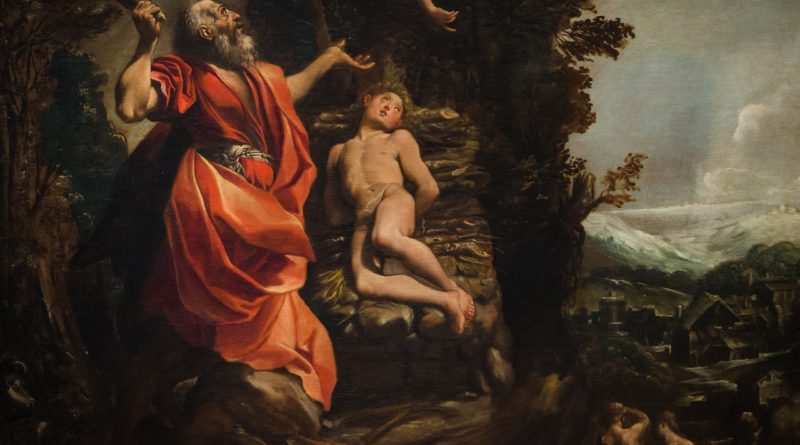Abraham and ‘Son of the Cup’
By Derek Gilbert
You are no doubt familiar with the basic outline of the story of Father Abraham: He faithfully followed God’s call and left his home in northern Mesopotamia, near Harran (it’s spelled with two Rs outside the Bible) and traveled to Canaan. God promised that his descendants would return from Egypt to Canaan and become a great nation.
As time passed, Abraham and Sarah began to doubt because they reached their senior years without a child and heir. Trying to jump-start God’s promise, Sarah gave her servant, Hagar, to Abraham, who promptly fathered Ishmael, considered the father of the Arabian tribes. But even with this display of disbelief, God reappeared to Abraham and Sarah and promised a son, who arrived in the form of Isaac, the son of the promise.
Most of us, reading this with a modern, Western worldview, interpret Abraham’s distress at the lack of an heir as the understandable sadness a father might have over not seeing his family line continue, or over leaving his (rather large) estate to an outsider.
After these things the word of the Lord came to Abram in a vision: “Fear not, Abram, I am your shield; your reward shall be very great.” But Abram said, “O Lord God, what will you give me, for I continue childless, and the heir of my house is Eliezer of Damascus?” (Genesis 15:1–2)
Having read this far into the chapter, you already have a better understanding of why Abraham was distressed about not having a son. Since he didn’t know what later prophets and the apostles knew about the afterlife, Abraham can be excused for thinking that he needed a son to call his name and feed him on the thirtieth of every month. Scholar Nicolas Wyatt explains Abraham’s angst at being childless by digging deeper into Genesis 15:2:
mâ titten-lî wĕʾānōkî hôlēk ʾărîrî ûben mešeq bêtî {hûʾ dammešeq} ʾĕlî ʿezer
What can you give me, since I am childless, and the one who will pour libations on my tomb… is Eliezer?
The expression hûʾ dammešeq is a scribal gloss, explaining what was felt to be a damaged text, since the meaning of mešeq was lost until the Ugaritic texts were found. It may be translated “that is, Damascus”, but is an ill-directed attempt to explain an obscure term, and should be omitted. Ben mešeq, “son of the cup”, alludes to the eldest son’s ritual duties at the obsequies of his father.

In short, Abraham wasn’t upset that he might have to leave his wealth to a distant relative in Damascus. In fact, Eliezer may not even have been related; he might have been the servant Abraham sent north to find a bride for Isaac. Abraham was distressed that he’d have to name a servant his ben mešeq, “son of the cup,” to pour the water every month for the kispum.
Oddly enough, this practice of “pouring the water” for the ancestors is one more religious rite that appears to be connected to, if not inspired by, the Watchers and Mount Hermon.
In September of 1869, Sir Charles Warren climbed the mountain as part of a survey of the Levant for the Palestine Exploration Fund. We quote an excerpt from his report for the PEF later in this book, but the relevant point right now is this: In addition to discovering a four-foot-high stela inside the ruins of a temple near the summit inscribed in archaic Greek with a reference to “those who swore an oath” (i.e., the Watchers), Warren found that the summit of the mountain was scooped out to form a giant bowl about nine feet across and at least six feet deep.
If you’re familiar with the Book of 1 Enoch, you probably know that the two hundred rebellious Watchers descended to the summit of Hermon and bound one another with a mutual oath before proceeding to mate with human women and corrupt most of the living things on the planet. The text of Enoch puts the event “in the days of Jared.”
Scholar Edward Lipiński, however, has a different view:
The word yarīd… is not the name of a person, as authors generally believe, but a cultic term denoting the rite of hydrophory, which consisted in going down to a well in order to draw water out of it and bring it up in procession to pour it out as a libation.
In other words, the descent of the Watchers didn’t take place in the days of Jared, it happened in the days of the yarīd, or perhaps in the days when the yarīd was introduced. Lipiński documents from classical sources that the ritual was performed at several places in the Levant, including Hierapolis (modern Manbij, Syria) to honor Atargatis, another name for the goddess Inanna/Ishtar, and Tyre, for the chief god of that city, Melqart—the Phoenician name for the most famous of the Greek demigods, Herakles.

The practice of venerating one’s ancestors predates Abraham’s day, but we can only definitely date the practice of the monthly care and feeding ritual, the kispum, to the rise of the Amorites around 2000 BC. It’s difficult to believe that religious rites based on the worship of ancestors would have continued for the last four thousand years without some evidence to compel cultures as different as modern, high-tech South Korea and rural Madagascar to continue them to this day.
While this won’t satisfy most scientists, who tend to limit the scope of their inquiries by denying the existence of anything that falls outside the definition of the “natural,” the only rational explanation for this long history of ancestor veneration is the intrusion of the supernatural in the physical realm, since it was fear of the power of the dead motivated Amorites to feed them in the first place.

As Christians, we understand that the dead only visit the living under special circumstances sanctioned by God. The only example in the Bible was the visit by the prophet Samuel to the medium at En-dor (1 Samuel 28:1–25). So, it’s safe to say that demands for food and drink from the dead weren’t coming from dead ancestors. Those demands came from another kind of spirit. They were spirits of the dead, all right, but not dead humans—dead hybrids. Nephilim.
In other words, what the Amorites of old believed were the spirits of their ancestors were actually demons.

Derek Gilbert hosts SkyWatchTV, a weekly Christian television program, and co-hosts SciFriday, a weekly television program that looks at science news with his wife, author, and analyst Sharon K. Gilbert. His broadcast career spans nearly four decades, with stops in Little Rock, Saint Louis, and Philadelphia, and he’s been interviewing guests for his podcast, A View from the Bunker, since 2009. Derek is author of the groundbreaking books The Great Inception and Last Clash of the Titans. He’s also the co-author with Josh Peck of The Day the Earth Stands Still, which exposes the occult origins of the modern UFO phenomenon. Bad Moon Rising: Islam, Armageddon, and the Most Diabolical Double-Cross in History was released in the summer of 2019. Derek and Sharon recently released Veneration: Unveiling the Ancient Realms of Demonic Kings and Satan’s Battle Plan for Armageddon, about ancient death cults and the Bible. Their newest book, Giants, Gods, and Dragons: Exposing the Fallen Realm and the Plot to Ignite the Final War of the Ages, was released November 30, 2020 and became a #1 “Hot New Release.” His newest book, The Second Coming of Saturn: The Great Conjunction, America’s Temple, and the Return of the Watchers, was just released on November 15. Derek is a popular conference speaker, a lifelong fan of the Chicago Cubs, prefers glasses to contacts, and has been known to sing the high part in barbershop and gospel quartets. Find out more: www.derekpgilbert.com, www.gilberthouse.org, www.vftb.net, and www.SkyWatchTV.com.



